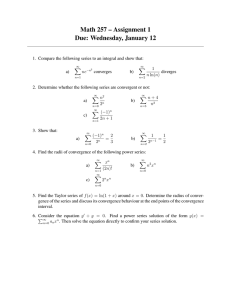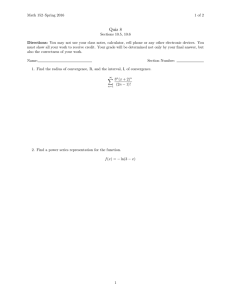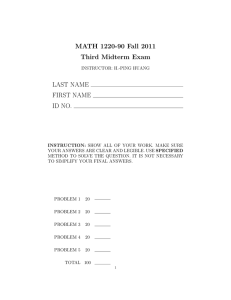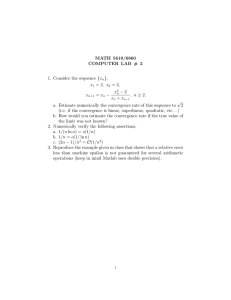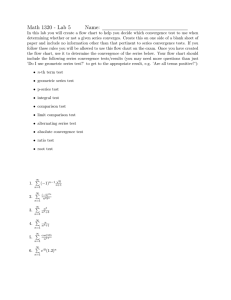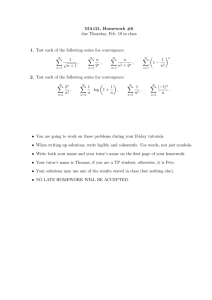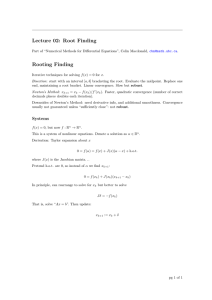Emmanuel Kakai Research & Development Telkom Kenya Regional Workshop for the Arab Region
advertisement
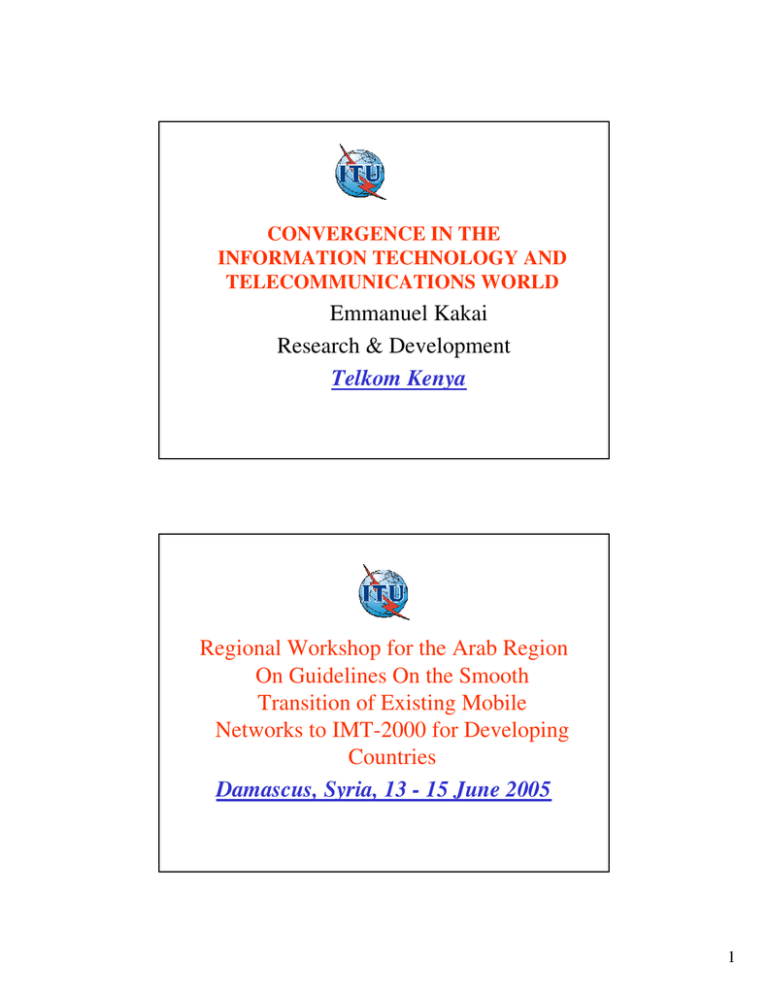
CONVERGENCE IN THE INFORMATION TECHNOLOGY AND TELECOMMUNICATIONS WORLD Emmanuel Kakai Research & Development Telkom Kenya Regional Workshop for the Arab Region On Guidelines On the Smooth Transition of Existing Mobile Networks to IMT-2000 for Developing Countries Damascus, Syria, 13 - 15 June 2005 1 CONTENTS • Introduction • Drivers for Convergence • Types of Convergence • Network Architecture for future IT &Communication • Impediments to Convergence • Conclusions INTRODUCTION • In the telecommunications world, • • convergence means a moving towards the use of one medium. The architecture selected for convergence must satisfy the business requirements before it meets the technical requirements The architecture for collaboration must address the IT infrastructure, both what is already in place and what can be implemented in the future 2 DRIVERS FOR CONVERGENCE Many drivers but perhaps the most significant is a vision of the future • Lower Cost • Simplified Provisioning • Easier Management • Less Maintenance • Fewer User Interfaces DRIVERS FOR CONVERGENCE • More Rapid Provisioning • Improved Service • New Services • Simplification of user’s Life 3 DRIVERS FOR CONVERGENCE A brief review of each driver LOWER COST • If a new technology is to gain any recognition and market share, it must promise some savings- the more the better. DRIVERS FOR CONVERGENCE SIMPLIFIED PROVISIONING • Transport/Physical level - Allows a reduction in the number of cables to be laid • Switching level - Reduces the number of cable plants needed within a building • Application level - Only one medium e.g. the Internet is required to deliver content 4 DRIVERS FOR CONVERGENCE EASIER MANAGEMENT • Separate networks means that managers have to coordinate data from multiple sources to determine service quality • Combination of multiple systems and Networks simplifies management of telecommunications services DRIVERS FOR CONVERGENCE LESS MAINTENANCE • Reduction in the number of cable plants required means a reduction in the maintenance required • Easier upgrades as demand grows and as the need to provision new services arise 5 DRIVERS FOR CONVERGENCE FEWER USER INTERFACES • Use of a single cable plant with appropriate switching results into fewer separate user interfaces • Single type of of plug in the wall, which supplies raw bandwidth on demand • Reduction in costs for eqpmt manufacturers and savings passed on to consumers DRIVERS FOR CONVERGENCE MORE RAPID PROVISIONING • When existing cabling can carry new signals, provisioning is much faster • When existing cabling and switching can allow new services to be engineered and deployed without the need to add either cable or switching equipment, provisioning can be extremely fast 6 DRIVERS FOR CONVERGENCE IMPROVED SERVICE • Service quality improves when fewer components are involved in provisioning and maintenance DRIVERS FOR CONVERGENCE NEW SERVICES • Design, implementation and provisioning of new services is faster • Use of IP as the common switching technology allows new telephone services to be deployed easily in VoIP networks • As more switching intelligence resides in user eqpmt, need for fixed services reduces in favour of guarantees on packet delivery 7 DRIVERS FOR CONVERGENCE SIMPLIFICATION OF USER’S LIFE • New technologies are hard to sell unless users can perceive tangible benefits • Users do not respond to “Technological elegance”, but to concrete improvements and documentable savings. • Converged solutions have foundered in the past because telcom executives did not view things through from the user’s standpoint TYPES OF CONVERGENCE • TRANSPORT • SWITCHING • APPLICATION • TELECOMMUNICATION/IT 8 TYPES OF CONVERGENCE TYPES OF CONVERGENCE CONVERGENCE PYRAMID- Four levels: • :Network convergence(transport) - LAN, WAN, Wired and Wireless transmission • IT infrastructure-Servers,workstations, etc. • Applications - Web servers and other forms of Input/output devices • User Interface. Offer the end user access to converged applications 9 TYPES OF CONVERGENCE TRANSPORT • Same physical pipes and transport technology carry multiple services, usually of different customers • Convergence at this level is primarily used by carriers to provision their infrastructure • Used for local access as well as reducing the customer’s overall telecommunication bill TYPES OF CONVERGENCE SWITCHING • Same cable plant carries different types of traffic, and does appropriate switching • Distinction between services becomes less distinct or disappears entirely • Users see a bit pipe, and services are defined by end-user equipment 10 TYPES OF CONVERGENCE APPLICATION (Content) • The same end- user device or type of device and network handles and delivers all content • User does not have separate network interface devices TYPES OF CONVERGENCE TELECOMMUNICATIONS/IT • Blurring of the distinction between telecommunications and information processing (use of Applications service Providers and network computing) • Separate functions historically provided by different manufacturers are now available through one source. 11 NETWORK ARCHITECTURE FOR IT&COMMS • CENTRALIZED • HORIZONTAL • HIERARCHICAL NETWORK ARCHITECTURE FOR IT&COMMS CENTRALIZED ARCHITECTURE • Places all the applications,management and network connections in a single point • Worked well when networks and computers were expensive • Initially used by large organizations 12 NETWORK ARCHITECTURE CENTRALIZED NETWORK ARCHITECTURE FOR IT&COMMS HORIZONTAL ARCHITECTURE • More flexible: allows sites to be added easily • Loss of one site does not bring down the operation of other sites • Modular approach can produce a longer lasting solution 13 NETWORK ARCHITECTURE HORIZONTAL NETWORK ARCHITECTURE FOR IT&COMMS HIERARCHICAL ARCHITECTURE • Resembles an organizational chart • Large enterprises like banks and schools with off-campus facilities fit this model • The architecture design is flexible and can last a long time. 14 NETWORK ARCHITECTURE HIERARCHICAL NETWORK ARCHITECTURE TABLE: COMPARISON 15 NETWORK ARCHITECTURE FOR IT&COMMS The architecture choice should increase productivity with the following goals for the user interface: • Consistent - Dependable and performs the same for every use • Obvious- Similar to other experiences, limiting training expenses and reducing errors • Intuitive- Should be easy to learn IMPEDIMENTS TO CONVERGENCE • No technology is perfect! Impediments to convergence have been underestimated or unrecognized leading to project failure. • Impediments have their roots in the failure to recognize how deeply engrained current services are in the business environment, regulatory arena and user mentality 16 IMPEDIMENTS TO CONVERGENCE • • • • • • Inertia needed to change infrastructure Regulatory Human Factors Protocol,Standards and Compatibility Issues Clash of cultures Need to Interoperate with existing Infrastructure and Applications • Unproven reliability and availability IMPEDIMENTS TO CONVERGENCE • Inertia Needed to change Infrastructure The existing network represents a considerable investment in time, material and effort • Regulatory- Massive governmental regulatory regime • Human Factors- Consumers have to be convinced that it is in their interest to make the switch 17 IMPEDIMENTS TO CONVERGENCE • Protocol,standards and compatibility issuesin some converged services the market has not stabilized thus standards and compatibility remains a potential problem • Clash of Cultures-Telecommunication and IT take polar views of how a network should run. Telcom staffers believe data Networks are unstable while IT managers tend towards networking(fast packet rates) IMPEDIMENTS TO CONVERGENCE • Need to Interoperate with existing infrastructure and applications - No new solution will be acceptable if it does not interoperate with existing systems and applications • Unproven Reliability and Availability-In case of major technological changes CEOs want to have proof that a new system will perform at levels equal to or exceeding the existing system 18 CONCLUSIONS • Best to view convergence from the broadest possible perspective. • Excessive focus on technological capabilities alone may lead to expensive and embarrassing project failures • “Make haste slowly”(Augustus Caesar)Best to be a market follower than a market leader THANK YOU! Emmanuel Kakai kakaiem@yahoo.com 19
